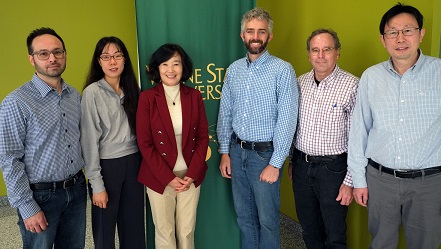
A multidisciplinary team of Wayne State University researchers is establishing the Barber Integrative Metabolic Research Program, thanks to an initial funding commitment of $1 million from the Barber Research Fund. The program is built on groundbreaking research at Wayne State that has identified a novel molecular target for treating metabolic diseases and treatment-resistant cancers.
The research, led by Christopher Kelly, Ph.D., associate professor of Physics and Astronomy in the College of Liberal Arts and Sciences, and James Granneman, Ph.D., professor of Molecular Medicine and Genetics in the Center for Molecular Medicine and Genetics, and of Internal Medicine in the School of Medicine, focuses on understanding the intricacies of cellular lipid metabolism. Imbalances in lipid metabolism are linked to the progression of catastrophic diseases, including diabetes, fatty liver disease and cancer.
The team has discovered that a key regulator of lipid metabolism, the protein ABHD5, can be targeted by natural and synthetic chemicals to regulate metabolism. Through medicinal chemistry, the team has developed a panel of potent ABHD5 activators and inhibitors that will be used to unravel the fundamental mechanisms of lipid metabolic control, including pathways that contribute to metabolic diseases and cancer. The project’s long-term goal is to develop new therapeutic entities for treatment-resistant diseases.
The program comprises three integrated arms, each led by distinguished researchers, including Dr. Kelly and Y. Mindy Huang, Ph.D., assistant professor of Physics and Astronomy, who will focus on the structural and biophysical bases of ABHD5 action; Dr. Granneman and Emilio Mottillo, Ph.D., associate scientist, Henry Ford Health, who will investigate cellular responses to synthetic activators and inhibitors in liver and fat cells; and Hyeong-Reh Kim, Ph.D., professor of Pathology, and Jian Wang, Ph.D., associate professor of Pathology, who aim to develop ABHD5 ligands into new therapeutic entities for treating fatty liver disease and treatment-resistant cancers.
“The Barber Integrative Metabolic Research Program is currently supported by two NIH and DoD grants, and the additional funding from the Barber Research Fund will further enhance critical integration within the team,” Dr. Granneman noted. “This collaborative effort is poised to make significant strides in metabolic research and advance innovative treatments for associated diseases.”
“This program integrates researchers from across our campus to develop solutions to serious problems faced by many,” said Timothy Stemmler, Ph.D., interim vice president for Research at Wayne State. “Faculty from Wayne State University’s College of Liberal Arts and Sciences, School of Medicine, the Division of Research, and Henry Ford Health will assemble in our Integrative Biosciences Building (IBio) as a demonstration of the importance of interdisciplinary collaboration. The goal of IBio is to coordinate research teams and programmatic initiatives to tackle critical urban challenges across a spectrum of disciplines, and this research is an excellent example of how our researchers are coming together to make a significant impact locally and globally.”
The Barber Research Fund has played a pivotal role in supporting interdisciplinary research and education at Wayne State for more than a decade. Its generous contributions have supported hundreds of students in hands-on research and dozens of collaborative projects. Dr. Kelly said Barber’s passion for science and medicine is inspirational.
“This program epitomizes the strength of integration, where diverse expertise becomes the key to unlocking novel frontiers in comprehending and addressing metabolic diseases,” Dr. Kelly said. “We are thrilled to unite a diverse team and collectively propel the frontier of science. The support from WSU and Mr. Barber will serve as the bedrock for groundbreaking insights and innovative treatments.”